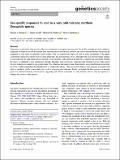Files in this item
Sex-specific responses to cold in a very cold-tolerant, northern Drosophila species
Item metadata
| dc.contributor.author | Parker, Darren J. | |
| dc.contributor.author | Envall, Tapio | |
| dc.contributor.author | Ritchie, Michael G. | |
| dc.contributor.author | Kankare, Maaria | |
| dc.date.accessioned | 2021-08-10T15:30:07Z | |
| dc.date.available | 2021-08-10T15:30:07Z | |
| dc.date.issued | 2021-04 | |
| dc.identifier | 271737708 | |
| dc.identifier | 834c9cc2-a301-4d3e-9f75-129ac88dea9a | |
| dc.identifier | 85099976159 | |
| dc.identifier | 85099976159 | |
| dc.identifier | 000612604500002 | |
| dc.identifier.citation | Parker , D J , Envall , T , Ritchie , M G & Kankare , M 2021 , ' Sex-specific responses to cold in a very cold-tolerant, northern Drosophila species ' , Heredity , vol. 126 , no. 4 , pp. 695–705 . https://doi.org/10.1038/s41437-020-00398-2 | en |
| dc.identifier.issn | 0018-067X | |
| dc.identifier.other | ORCID: /0000-0001-7913-8675/work/98785484 | |
| dc.identifier.uri | https://hdl.handle.net/10023/23752 | |
| dc.description | Funding: This work was supported by Academy of Finland projects 268214 and 322980 to MK and a NERC (UK) grant NE/P000592/1 to MGR. | en |
| dc.description.abstract | Organisms can plastically alter resource allocation in response to changing environmental factors. For example, in harsh conditions, organisms are expected to shift investment from reproduction toward survival; however, the factors and mechanisms that govern the magnitude of such shifts are relatively poorly studied. Here we compared the impact of cold on males and females of the highly cold-tolerant species Drosophila montana at the phenotypic and transcriptomic levels. Although both sexes showed similar changes in cold tolerance and gene expression in response to cold treatment, indicating that the majority of changes are concordant between the sexes, we identified a clear reduction in sexually dimorphic gene expression, suggesting that preparing for the colder season involves reducing investment in sex-specific traits. This reduction was larger in males than females, as expected if male sexual traits are more condition-dependent than female traits, as predicted by theory. Gene expression changes were primarily associated with shifts in metabolic profile, which likely play a role in increasing cold tolerance. Finally, we found that the expression of immune genes was reduced following cold treatment, suggesting that reduced investment in costly immune function may be important in helping flies survive colder periods. | |
| dc.format.extent | 11 | |
| dc.format.extent | 2118620 | |
| dc.language.iso | eng | |
| dc.relation.ispartof | Heredity | en |
| dc.subject | Drosophilia montana | en |
| dc.subject | Cold tolerance | en |
| dc.subject | Resource allocation | en |
| dc.subject | Sex-specificity | en |
| dc.subject | QH301 Biology | en |
| dc.subject | QH426 Genetics | en |
| dc.subject | Genetics | en |
| dc.subject | Genetics(clinical) | en |
| dc.subject | DAS | en |
| dc.subject.lcc | QH301 | en |
| dc.subject.lcc | QH426 | en |
| dc.title | Sex-specific responses to cold in a very cold-tolerant, northern Drosophila species | en |
| dc.type | Journal article | en |
| dc.contributor.sponsor | NERC | en |
| dc.contributor.institution | University of St Andrews. School of Biology | en |
| dc.contributor.institution | University of St Andrews. Centre for Biological Diversity | en |
| dc.contributor.institution | University of St Andrews. Institute of Behavioural and Neural Sciences | en |
| dc.contributor.institution | University of St Andrews. St Andrews Bioinformatics Unit | en |
| dc.identifier.doi | https://doi.org/10.1038/s41437-020-00398-2 | |
| dc.description.status | Peer reviewed | en |
| dc.identifier.grantnumber | NE/P000592/1 | en |
This item appears in the following Collection(s)
Items in the St Andrews Research Repository are protected by copyright, with all rights reserved, unless otherwise indicated.

